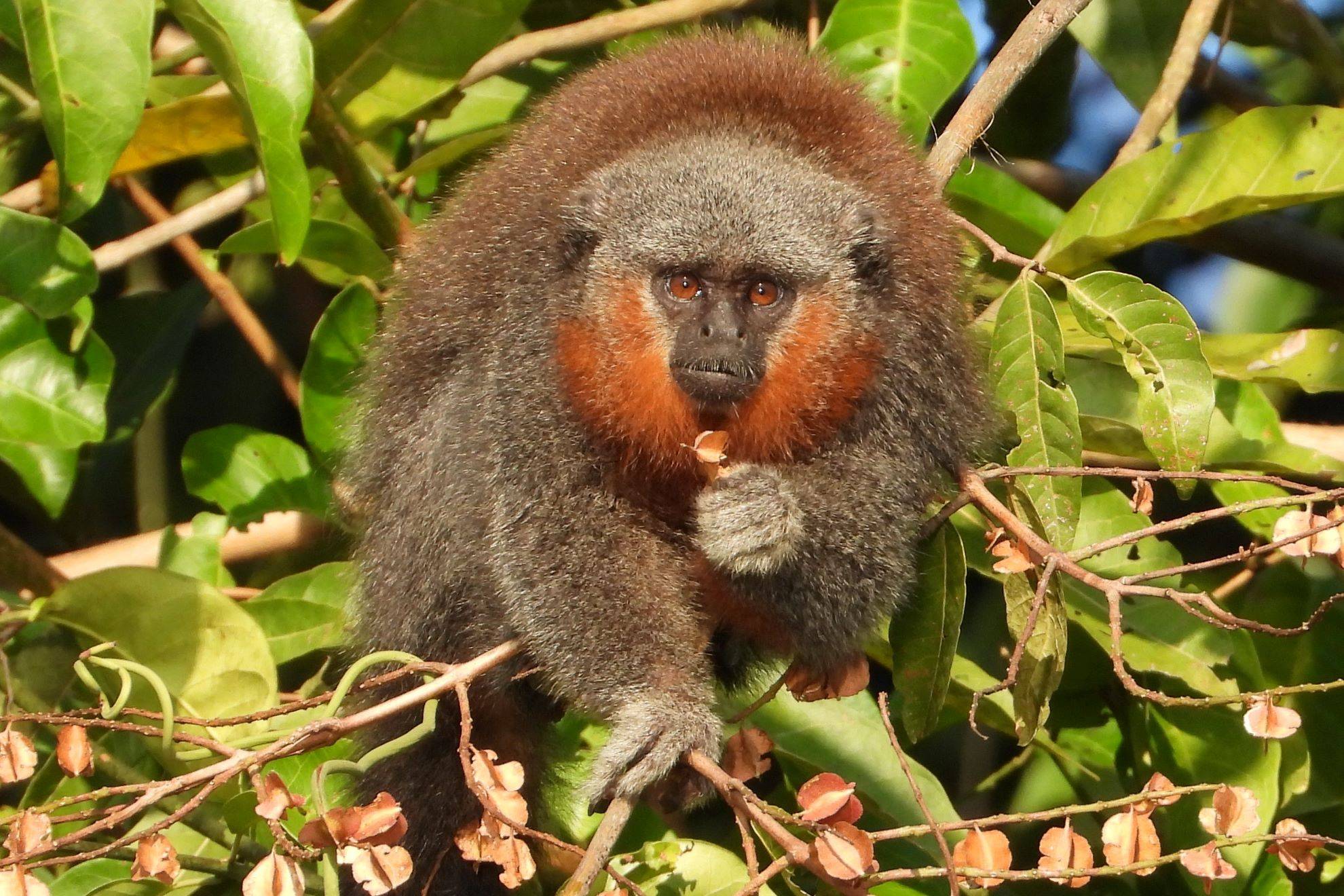Through the airplane window flying over the northern region of the state of Mato Grosso, one can see patches of forest, cut into various shapes and sizes, isolated amidst vast plantations and pastures. Depending on the time of year, this landscape dominated by soy, corn, cotton, and cattle is clouded by another striking element of the region: smoke. During the dry season, fires are frequent in the world’s largest continuous tropical forest. It is here, between the fires and the progressive destruction of nature that give name to the Arc of Deforestation, that one of the world’s most endangered primates resides.
The Mato Grosso titi monkey (Plecturocebus grovesi), as the name suggests, is restricted to this state. Its distribution is limited to the north by the confluence of the Juruena and Teles Pires rivers, two massive water barriers that border its habitat. To the south, the species’ geographical boundaries are still uncertain, but researchers believe they reach the transition between the Amazon and Cerrado domains. This distribution unfortunately overlaps with the most dangerous region of the Amazon for a primate: the Arc of Deforestation, the front where the main pressures that bring down the forest have historically advanced through. The species, recognized by science only in 2018, was born into an endangered cradle.
In the municipality of Alta Floresta, where the species was discovered, for example, the deforestation rate increased more than tenfold between 2012 and 2022 (from 1.55 km² to 16.33 km²), according to data from the Prodes monitoring program, produced by the National Institute for Space Research (INPE). In total, around 120 km² of forest were destroyed during this period within the municipality alone.
In contrast, according to data from MapBiomas, the area occupied by agriculture and livestock in Alta Floresta has more than tripled. It jumped from 116,872 hectares in 1985 to 440,113 in 2021, which is almost half of the municipality. The phenomenon of expanding plantations and pastures and shrinking forest cover is repeated in other municipalities in the north of Mato Grosso.

Mato Grosso is one of the states contributing the most to Amazon deforestation. According to recently released data from Prodes, between August 2021 and July 2022, the state lost 1,938.99 km² of Amazon Forest – an area larger than the city of São Paulo.
In a race against time and destruction, researchers seek new information about the species. Currently, the Mato Grosso titi monkey is known to exist in only six municipalities – Paranaíta, Alta Floresta, Juara, Nova Bandeirante, Apiacás, and Sinop. There are only two confirmed sightings within protected areas: in Juruena National Park and Rio Ronuro Ecological Station. Researchers suspect that the species will also be found within indigenous lands in the region, but were not able to confirm it yet.
Primatologist Gustavo Canale, associate professor at the Federal University of Mato Grosso (UFMT), is one of the twenty authors of the article that introduced the Mato Grosso titi monkey to the scientific world. According to him, research efforts are currently focused, in part, to confirm the species’ distribution and determine its southern limit.
“We have already confirmed the species here in the municipality of Sinop, and there are some populations that we know occur around the region of Lucas do Rio Verde. Then we will go further down in the transition, entering the Cerrado of the state, to see if the southern limit of this species’ distribution, as we imagine, is this transition between the Amazon and Cerrado. So where there is actual Cerrado, the species should not occur,” he explains.
Excursions to the region are underway this December, and they count with researcher Jean P. Boubli from the University of Salford (England), the first author of the study that described the Mato Grosso titi monkey. The first expedition confirmed the species’ occurrence in the right bank of the Arinos River and reinforced the suspicion that the river is the primate’s western boundary, Gustavo says.
The expeditions to map the species’ distribution will go as far as the municipality of Nova Mutum. The research is being carried out by the Ecótono Institute, in partnership with UFMT and the University of Salford, with support from Re:wild through the Primate Action Fund/Margot Marsh.
An ever-shrinking home
The Mato Grosso titi monkey is an arboreal primate, living and moving in the treetops. It is precisely this relationship with forest cover that makes primatologists sound the alarm about the animal’s future.
In the 2018 study that described the species, the authors show that the Mato Grosso titi monkey had already lost 42% of its forest habitat by 2017. They predict that if deforestation in the region continues at its current pace, this loss could reach 86% by 2042, the equivalent to three generations of the primate.
In the article, the researchers also warn about the ongoing political trend of undermining and reducing protected areas in the Brazilian Amazon, and about the hydroelectric dam complex planned for the region.
“There are still two large blocks of forest where this species occurs, but it is certainly a declining population. Although it is not yet a small population, it is one that is rapidly reducing due to the intense deforestation. The fact that this deforestation in northern Mato Grosso is one of the fastest on the planet is what puts this species on alert. We are losing individuals very quickly,” explains Gustavo Canale.
The primatologist explains that since the species was described relatively recently, its total population size has not yet been estimated, and there is no data on abundance and density in the fragments where they occur.
“It was classified as Critically Endangered due to projections of expected deforestation, based on the current deforestation rate. That’s why it’s endangered: because if things continue as they are, we imagine that we will lose more and more forest until the species becomes extinct,” warns the primatologist.

Gustavo explains that since this deforestation is relatively recent, there are still large patches of forest. “But these forests are becoming increasingly fragmented. These titi populations, some are in very small fragments, and it is already quite evident that they are not viable in the long term,” he explains.
Deforestation is currently the main threat to the Mato Grosso titi monkey. And along with forest clearing comes a second problem: fire. The Amazon in northern Mato Grosso, where the monkey lives, is classified as an ecoregion known as “Mato Grosso dry forests,” and is naturally more susceptible to fires. Deforestation makes this phenomenon even worse.
“The place where the Amazon loses the most forest is in the Arc of Deforestation, and the titi lives within it, with its entire distribution area. And this region, where deforestation is very intense, becomes dryer, leading to frequent forest fires. Imagine a population already isolated in a small fragment. If a fire hits that small fragment, it’s over; they have nowhere to run. They are surrounded by fire,” describes the UFMT professor.
Together with the expansion of agriculture and livestock farming come the expansion of the road networks, urban development, and the construction of hydroelectric plants, which also compete for space and impact the Mato grosso titi monkey’s habitat.
In addition to these well-known problems, Gustavo is also concerned about the information gaps in our knowledge of the species, and the potential hidden problems within them. “We might need a little more research to better understand the species’ genetic variability. I wouldn’t risk guessing today, due to the limited information we have, how severely inbreeding effects [reproduction between related individuals] and deleterious effects of very small populations affect the titi monkey, but they probably do,” he summarizes.
One of the world’s most endangered primates
The researchers’ warning gained international attention in August of this year when the Mato Grosso titi monkey was included in the list of 25 most endangered primates in the world. The list comes from the publication Primates in Peril, produced by Re:wild. Its latest edition, for the biennium 2022-2023, was launched during the Brazilian Primatology Congress, which took place precisely in northern Mato Grosso, in the municipality of Sinop.
“For all the animals we chose as the most threatened, we thought about whether there are people who will really use this attention of being one of the 25 most threatened to really act for conservation. And this is happening here, there are many people fighting to save this species,” comments British primatologist Anthony Rylands, director of primate conservation at Re:wild, in a conversation with ((o))eco during the event organized by the Brazilian Society of Primatology (SBPr).
Shortly after the Congress, on September 1st, Rylands and the Chief Conservation Officer of Re:wild, primatologist Russell Mittermeier, embarked on an excursion to see the Mato Grosso titi up close – and to see an example of the dramatic fragmentation the species is subjected to.
Chronicles of an isolated couple
The small primate watching team was composed of Mittermeier, Rylands, and six other primatologists, guided by UFMT researcher and professor Gustavo Canale, then president of the Brazilian Society of Primatology. The group left Sinop and traveled for about an hour and a half along the roadway, a path that starts on the asphalt of MT-222 and ends on dusty dirt roads. Halfway there, the group crossed the bridge over the Teles Pires River – an insurmountable barrier for many primates, but not for humans.
The group’s destination is the settlement where Armando Antônio, 60, lives. Originally from the municipality of São Miguel do Iguaçu, in the state of Paraná, he is one of many who came from the southern region of Brazil to occupy this part of the Amazon. The name Sinop, in fact, derives from the acronym of Sociedade Imobiliária Noroeste do Paraná (Northwest Paraná Real Estate Society), the company that implemented the city’s urban project.
In Armando’s “backyard”, in a forest fragment of less than 5 hectares, lives an isolated couple of Plecturocebus grovesi, the Mato Grosso titi monkey. The presence of one of the most endangered primates in the world in a tiny Amazon “island” surrounded by pasture serves as a dramatic portrait of the impacts deforestation imposes on the species.

The fragmentation, however, was caused not only by chainsaw, but also by waters from the Sinop hydroelectric plant, which began operating in September 2019. “I had 80 hectares of land. The plant flooded 40 and took my Legal Reserve,” complains Armando, who owns a pasture and raises dairy cattle on his property.
With the damming caused by the plant, the Matrinxã River, originally a small stream, became a 300 meter wide river in that stretch. The water rose, and the Mato Grosso titi monkey habitat shrank and broke apart even more.
“I’ve lived here for 23 years. They always sing in the morning. In the past, there were many, and each sang in turn. I always heard them, but had no idea they were an endangered species. They’ve always been here, but the forest used to be all connected, so it was just one group. It wasn’t until the construction of the hydroelectric plant, which flooded the land and separated them, that it became easy to find them. The forest is larger over on the other side, and it’s more difficult to see them,” says Armando.
Gustavo says they’ve heard titi monkeys vocalizations coming from the other side of the river, and estimates there are at least two groups on the other bank. In another fragment, about a kilometer away, there is another isolated group. “What we need to do is restore and reconnect these areas,” the primatologist points out.

Part of this reforestation work is in the hands of Sinop Energia, the company responsible for the Teles Pires hydroelectric plant, and in charge of restoring the riverbanks affected by the dam, such as Armando’s little forest, as they are Permanent Preservation Areas (APP).
((o))eco contacted Sinop Energia’s press office to find out why restoration has not yet been carried out and whether there is a timeline for the project, and also to clarify if the company is aware of the presence of an endangered species in the area impacted by the plant.
According to a statement from the press office, “Sinop Energia is restoring the Permanent Preservation Areas through a specific program, assisted by EMBRAPA and monitored by the State Secretariat of Environment/MT. The execution schedule approved by the environmental agency is up to date, and Sinop Energia has already restored 404 hectares. The company also maintains a seedling nursery at the Sinop hydroelectric plant, with a production capacity of 150,000 seedlings/year. In addition to restoring the APP, the nursery fulfills a social function, donating seedlings to neighboring municipalities, NGOs, and rural resettlements.”
Furthermore, the company explains that it has developed the Wildlife Dispersal and Rescue Program due to the filling of the dam’s reservoir, and that about 28,000 animals have been rescued, including 1,200 primates, of which 257 were titi monkeys – of both Plecturocebus vieirai, a species from the other bank of Teles Pires, and Plecturocebus grovesi. According to the statement, Sinop Energia has been carrying out a terrestrial fauna monitoring program since 2015, which includes primates like the Mato Grosso titi, and is regularly supervised by the State Secretariat.

“If this APP is completely restored, as it should be, the company will have reforested a 100-meter buffer around the 30,000-hectare reservoir. If this area is restored, many P. grovesi areas would be reconnected, including the one in Armando’s backyard. But for now, it’s not being done. So, through the Ecótono Institute, we are working with the People Affected by Dams Movement [MAB] to pressure the company to expedite this restoration,” says Gustavo, who is also a counselor of the Institute.
An alternative approach to speeding up restoration has been to independently seek funding and submit projects focused on this specific purpose. One of them, already pre-approved, says Gustavo, involves planting trees with community support, and it is based on rural schools of local settlements. The idea is to go beyond restoring the habitat of the titi monkey and other animals by also promoting community-based tourism.
The titi monkey’s sex life
As if the numerous threats surrounding the Mato Grosso titi monkey weren’t enough, the species faces challenges from its own biology and slow reproduction. With monogamous behavior, titi monkeys typically give birth to a single offspring per year. Groups consist of the parents and one or two offspring, from the previous reproductive cycle and/or the current year. Upon reaching sexual maturity, the offspring will disperse to find a mate, form a new family, and occupy another territory. However, without forests, there’s nowhere to go.
When a couple is isolated in a forest fragment, their offspring will end up reproducing among themselves, a process called inbreeding, which is detrimental to the population’s genetic health and facilitates the emergence of diseases.
Face to face with the Mato Grosso Titi Monkey
There’s no doubt from an ecological point of view that Armando’s small forest island is incapable of guaranteeing the long-term survival of a titi pair, which would produce offspring doomed to mate with relatives (endogamy), suffer genetic impoverishment, and face the scarcity of resources that such a precarious environment would eventually impose on the animals.
From a tourism perspective, however, the presence of Mato Grosso titi monkeys in the fragment provides a unique and easily accessible opportunity for primate watching. It took the primatologist group no more than a ten-meter walk into the fragment. Gustavo Canale, a professor at UFMT, pulled out a small speaker and played a recorded vocalization of a titi monkey . The playback technique, widely used in wildlife observation activities, especially for birds, yielded immediate results.

Living up to their territorial behavior, the titis quickly came to investigate the intruders in their diminished home. With agile movements atop the tree canopy, between 15 and 20 meters high, they blended among the leaves with their brown, reddish, and gray fur. My limited camera struggled to capture the animals, but neither the zoom, focus, nor the restless monkeys themselves cooperated with my shots. And even if it wasn’t always possible to see them clearly, it was impossible not to hear them when they vocalized. The monkey’s singing is a way of defending their territory, a way of showing us that their house has an owner.
When the titi pair finally settled on a branch to watch us from a distance, it was possible to observe a particular behavior of the species: the intertwining of their long tails. All black and almost 50 centimeters long, a P. grovesi’s tail is larger than its body. The intertwining is a sign of closeness between individuals, usually seen in couples or between parents and offspring, and is common throughout the Plecturucebus genus, a name that precisely means “monkey that coils its tail.”


Regardless of the quality of the photographs, the excitement of observing Mato Grosso titi monkeys spread through the team. Experienced primatologists Russell Mittermeier and Anthony Rylands celebrated as if those were the first monkeys they ever spotted. In reality, Russ had already observed over 400 primate species in the wild at that moment. A number he would expand less than an hour later, in that same fragment, when he spotted the also endangered Schneider’s marmoset (Mico schneideri).
We were able to observe at least three marmoset individuals, but Gustavo emphasizes that he doesn’t know exactly how many individuals of the species live there. “They are refugee primates,” he concludes.
Conservation strategies
Having been formally described by science only five years ago, there are still many uncertainties about the future of the Mato Grosso titi monkey and the strategies needed to ensure its conservation. Two things, however, are widely agreed upon: it is essential to curb deforestation in northern Mato Grosso and carry out forest restoration to reconnect isolated fragments.
The species has not yet been formally included in the National Action Plan (PAN) for Amazonian Primates, a tool managed by ICMBio (Brazilian federal institution responsible for managing protected areas and biodiversity) to address the conservation of threatened species. However, Gustavo explains that the conservation of the species has already been discussed by members of the Primate Specialist Group/Species Survival Commission of the International Union for Conservation of Nature (IUCN), of which he is a member, and consultations have also been held with the Brazilian Primatology Center/ICMBio. “But the conversations are very preliminary because we still don’t have a clear idea of where these isolated populations are. We are just beginning to map them now.”
“If you find an isolated population with no chance of reconnection, the idea would be to carry out a translocation because a very small, isolated population, with just one or two pairs, for example, is not viable. But the ideal is always to reconnect the forest and not simply remove the individuals from there. The most extreme measure would be this translocation. That’s why we’ve been seeking to write projects and find partners who want to work on forest restoration and connecting forest fragments where this species occurs,” explains the primatologist.
Another conservation strategy on the horizon, albeit in its early stages, is ex situ management, which means taking actions outside of the species’ natural habitat, such as in captivity. As the species was recently described, there is no information about the presence of these animals in wildlife triage centers or even zoos. “For now, the focus is mainly on in situ [in nature] populations. But in the future, it will undoubtedly be necessary to better organize efforts to determine where these individuals are, if they exist, and how the ex situ population is structured. Especially since there are many highways and urban expansion in the [P.] grovesi area, so it’s very likely that animals will start showing up injured or electrocuted in triage centers and veterinary hospitals, and it’s important to organize where these populations that will remain in captivity will go,” assesses Gustavo.
A Primate Destination
Seeing two endangered primate species in the wild, both described in the last five years and easily accessible near an urban center, is certainly not an everyday occurrence. Sinop offers a unique primate-watching opportunity. There are ten primate species that can be spotted in the municipality. This impressive diversity results from the Teles Pires River, a barrier that separates species but not the city of Sinop, which stretches along both banks of the river.

Even in the urban center, a stroll through Sinop’s Forest Park may offer glimpses of species such as Plecturocebus vieirai, a member of the titi monkey family; the white-cheeked spider monkey (Ateles marginatus); and the Emilia’s marmoset (Mico emiliae).
“The IUCN Primate Specialist Group, which I’m part of along with other colleagues, has been thinking about primate-watching as an important conservation tool,” says Gustavo Canale. “I’d argue that there’s no better place in the world for primate-watching than Brazil since it has the highest diversity of primates globally. If we narrow our focus to Mato Grosso, there are 29 species in the state. If Mato Grosso were a country, it would rank 13th in the world for primate diversity. This is quite remarkable.”
“The idea is to demonstrate through symbolic species like [P.] grovesi that there are other options,” says IUCN Primate Specialist Group director Russell Mittermeier. “It shows that deforestation isn’t the only economic option here. There’s the possibility of ecotourism using primates and other animals as symbols. It’s difficult to compete with the economic force of destruction, but the ecotourism industry can provide alternatives while protecting the forest for future options like the carbon market.”
“Sinop is a strategic location for developing this tourism due to the number of species and the existing infrastructure, such as roads, hotels, and restaurants. Imagine a national itinerary where tourists can see the golden lion tamarin [native to the state of Rio de Janeiro] and the titi monkey on the same trip?” Gustavo suggests. The challenge is to ensure the latter’s survival in the forests of Mato Grosso.
*Original text translated from portuguese by Bernardo Araújo
Leia também

From tropical forest explorer to nature defender
Renowned primatologist Russell Mittermeier reveals that Tarzan was the hero of his childhood and, along a couple of adventurous naturalists, his inspiration for a life-long career as a conservationist →

How Brazil is working to save the rare lion tamarins of the Atlantic Forest
Golden lion tamarin conservation efforts have been successful, growing the population from a one-time low of 200 animals to more than 2,000 today. →

Brazil’s Atlantic Forest gets a chance at a fresh start through restoration
Over the past five centuries, the Atlantic Forest has been exploited, occupied and gradually exterminated. A biome that once stretched along almost the entire coastline of Brazil has given way to cities where 70% of the country’s population today lives. What remains of the forest is just a fraction of what it used to be. →








